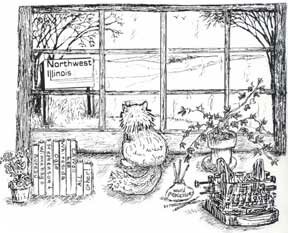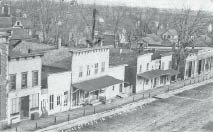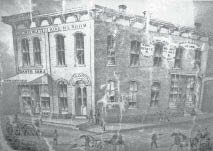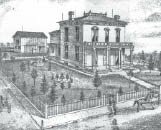
Discover rewarding casino experiences. 
|
To use Lanark as an example(!), for about the first decade of its struggle to get on its feet, there were such as the Compton’s, Page’s, Wolf, Paley, and so forth, who were called “capitalists” then but money lenders to use a more basic phrase. But as permanency seemed assured a solid brick edifice was built on the northeast corner of Broad and East Locust, known as the “Post Office Block,” it being the important postal facility in its back rooms. Giles VanVechten was the bank’s proprietor as you can see (top right) from the sign above the front door, this in the late 1860’s. He also built the impressive brick residence at what became the north entrance to the cemetery, a landmark, that in the twentieth century became the “Erisman house.” It still stands as does the downtown commercial building that only in 1870 became the “First National Bank.” It had a working capital of $50,000, later advanced to $100,000. This sketch was taken from a huge canvas-like map of Carroll County with illustrations of important county buildings, businesses and residence, which may well have had to be paid for by their owners to be printed, many of them Lanark. There so far is no identification as to printer—but it is thought the date of it is 1868-1869. The “Van Vechten Bank” rather confirms that, 1870 being the inauguration of the First National! Sue Appel answered one of my long held dreams by copying the Lanark scenes and given them on a silver platter, or something like that! Oh, many thanks Sue. They tell a lot.
At the east rear south side, the stairway leads to the second level. In the twentieth century to its left the Carroll Service had an office and to its right was the post office. The front and south walls sport advertisements of J.R. Howlett, real estate, insurance, notary, printer, editor. The first newspaper, the “Lanark Banner,” but which was NOT at this location to begin with. That later on. An iron railings guarded the down stairway to the basement where usually a barber shop was located for years. A similar railing and stairs down was at the Shumway building opposite, west. There was also at the high curb for years, well into mid-twentieth century, an iron hitching rail to tether horses in the ‘olden days.’ It was bent, resting on wooden posts and kids used to swing on it or straddle the railing even with no memory of the days of their original use. The post office remained in the bank block until about 1950 when a new building was erected next to the then Masonic Temple, now Heritage Community Center. It shared the building with Hygienic Fabrics which now occupies the entire. A roomier post office building was built on Rts. 64/52 in 1998 so but the mail still goes through.
In 1872 a “brick bakery” was built onto the east rear of the National Bank. Its large ovens yielded yeasty aromas downtown from the earliest hours when Ed Glotfelty began punching down the dough. It was also a confectionery, a popular ice cream spot, don’t ya know. Ed sold to his brother Milton the next year but eventually the expanding services of the post office took over the room, a large high ceilinged, dun colored place with the wall of shiny postal boxes to the north and the clerk’s cage to the right. Stories are numerous of Petey Wales’ long term as postmaster (Millie Flickinger, the assistant) and Petey’s two enormous Great Dane dogs that would put their paws on the counter and slobber on it to greet the customer. Petey ran the silent movie circuit for years showing the feature film and playing the piano to further the story. A small town character of the best sort. The facade shouts “Reading Room” which could have been part library before the White sisters accommodated the public with shelves of books in their living room, but also tables of newspapers and periodicals exchanged with the Lanark newspaper in the traditional way ... Columns of the news then “exchanged” items to interest the reading public. And their opinions of other editors opinion! Sometimes the exchange was vitriolic.
John Rathbone Howlett was one who never let his opinion remain unspoken. He is my favorite “person of the past,” having collected material about him for years as found by chance. There are still things to be discovered but five-six years ago a letter was received from Howlett’s great-great grandson Out East, he having found PDQ Me on the internet, referencing Lanark which he knew to have been his relative’s home Out West. We began correspondence to one another’s advantage, I hope, and have been able to learn many “newsy” items about our mutual interest. He didn’t know the Howlett’s had three children other than the one he’d known of in York state. And the pictures he sent of the family. Oh, wonderful! Herewith is a “biography” of John Howlett that, hopefully, will be added to as time brings to light other information. To begin with there is lots of discrepancy about the date of the “Lanark Banner’s” beginning ... Some give 1863 and other places state 1864. We are proponent of 1864 for a number of reasons; number one being subtraction. Several places Howlett states that, for instance, “This year, 1873, commences our tenth year,” meaning that nine years have passed. Seventy-three minus nine is sixty-four! And “With this issue, April 22, 1871, the 8th volume begins.” Subtract seven years of publishing from 1871 and it’s 1864! From “Newspapers and Periodicals in Illinois, 1814-1879”—”Lanark—the ‘Banner’—1864-1871, Published by John R. Howlett from 1864-1867 when he sold to J.E. Millard who discontinued it in 1871.” And Howlett didn’t arrive in Lanark until 1864 according to the state Veteran’s record. Question number 12 asks where he lived following service in the Union Army. Answer? Lanark, Illinois, 1864. Howlett had come to Ogle County in October of 1858 to begin the “Lane Leader” at Lane or Lanesville, now Rochelle, the sheet being “sharp and of considerable vim.” It was the first newspaper east of the Rock River according to Henry Boss, editor of the “Polo Advertiser” who in 1859 wrote a short “History of Ogle County” in which he wrote a short “History of Ogle County” in which he said, “The Banner met with good support, a fact no less creditable to the citizens of Lane than to the publisher.” Boss went on to say, “ Howlett used plain English and as a consequence lost some support otherwise might have been accorded him. A man of great energy. The newspaper continued until the summer of 1861 he was compelled to abandon the “Leader” which was sold to James Butterfield (Lane Patriot).” John Howlett then enlisted in the Union Army December 1, 1861, apparently for a six months tour of duty but he re-upped in spring 1862, rising from a private to lieutenant, an adjutant which was an officer on the staff of the commanding officer with administrative duties. At the Battle of Paducah he succeeded Capt. Hollenbeck as Provost Marshall. We have no record of further service; no when he was discharged other than the previously mentioned fact that he arrived in Lanark in 1864. “Muster and Discharge Register” state files show that he enlisted to “Co. A, 2nd Calvary, 1st Battalion, Ogle County” and that he was 5 feet 7 inches tall, had light skin and hair and blue eyes. “A man of great energy,” Boss said. He was 35 years old when he enlisted. Many of those enlisting then were over thirty. How he came to Lanark is only to be guessed at but he did say in comment in later years that “He grew up with the town,” then but three years old. The “Lanark Banner” was first housed in a two story wooden clapboard building on the east side of Broad, midway. It was also said to have housed one of the first school rooms, probably a “subscription school,” parents paying for children to be taught. Later it was known as the “Teachout” building but in the early ‘20’s it was razed to make way for the Rock Creek Township building, a fraternal twin to the then Masonic Temple going up of the same brick at the time. Perhaps the “Banner” was located there until 1867 when Howlett sold the paper to J.E. Millard then going to Shannon to begin another weekly. The next few years were filled with location changes, name changing and name calling. Learn more next week about the newspaper history in a small town.
|







